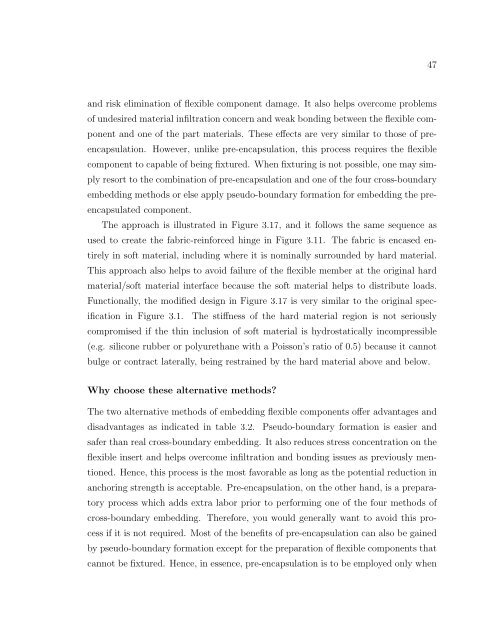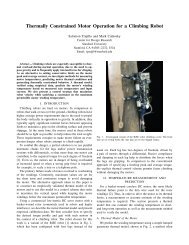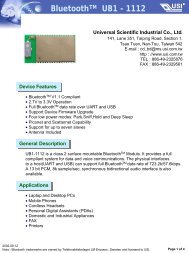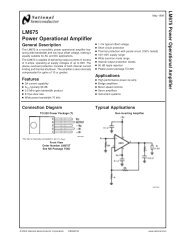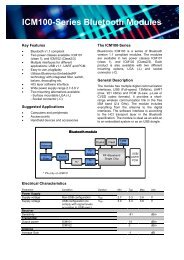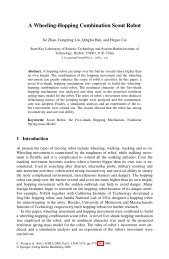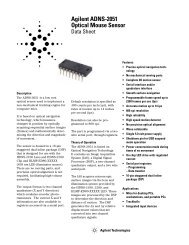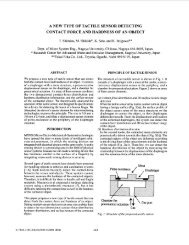design and fabrication of multimaterial flexible mechanisms with ...
design and fabrication of multimaterial flexible mechanisms with ...
design and fabrication of multimaterial flexible mechanisms with ...
You also want an ePaper? Increase the reach of your titles
YUMPU automatically turns print PDFs into web optimized ePapers that Google loves.
47<strong>and</strong> risk elimination <strong>of</strong> <strong>flexible</strong> component damage. It also helps overcome problems<strong>of</strong> undesired material infiltration concern <strong>and</strong> weak bonding between the <strong>flexible</strong> component<strong>and</strong> one <strong>of</strong> the part materials. These effects are very similar to those <strong>of</strong> preencapsulation.However, unlike pre-encapsulation, this process requires the <strong>flexible</strong>component to capable <strong>of</strong> being fixtured. When fixturing is not possible, one may simplyresort to the combination <strong>of</strong> pre-encapsulation <strong>and</strong> one <strong>of</strong> the four cross-boundaryembedding methods or else apply pseudo-boundary formation for embedding the preencapsulatedcomponent.The approach is illustrated in Figure 3.17, <strong>and</strong> it follows the same sequence asused to create the fabric-reinforced hinge in Figure 3.11. The fabric is encased entirelyin s<strong>of</strong>t material, including where it is nominally surrounded by hard material.This approach also helps to avoid failure <strong>of</strong> the <strong>flexible</strong> member at the original hardmaterial/s<strong>of</strong>t material interface because the s<strong>of</strong>t material helps to distribute loads.Functionally, the modified <strong>design</strong> in Figure 3.17 is very similar to the original specificationin Figure 3.1. The stiffness <strong>of</strong> the hard material region is not seriouslycompromised if the thin inclusion <strong>of</strong> s<strong>of</strong>t material is hydrostatically incompressible(e.g. silicone rubber or polyurethane <strong>with</strong> a Poisson’s ratio <strong>of</strong> 0.5) because it cannotbulge or contract laterally, being restrained by the hard material above <strong>and</strong> below.Why choose these alternative methods?The two alternative methods <strong>of</strong> embedding <strong>flexible</strong> components <strong>of</strong>fer advantages <strong>and</strong>disadvantages as indicated in table 3.2. Pseudo-boundary formation is easier <strong>and</strong>safer than real cross-boundary embedding. It also reduces stress concentration on the<strong>flexible</strong> insert <strong>and</strong> helps overcome infiltration <strong>and</strong> bonding issues as previously mentioned.Hence, this process is the most favorable as long as the potential reduction inanchoring strength is acceptable. Pre-encapsulation, on the other h<strong>and</strong>, is a preparatoryprocess which adds extra labor prior to performing one <strong>of</strong> the four methods <strong>of</strong>cross-boundary embedding. Therefore, you would generally want to avoid this processif it is not required. Most <strong>of</strong> the benefits <strong>of</strong> pre-encapsulation can also be gainedby pseudo-boundary formation except for the preparation <strong>of</strong> <strong>flexible</strong> components thatcannot be fixtured. Hence, in essence, pre-encapsulation is to be employed only when


